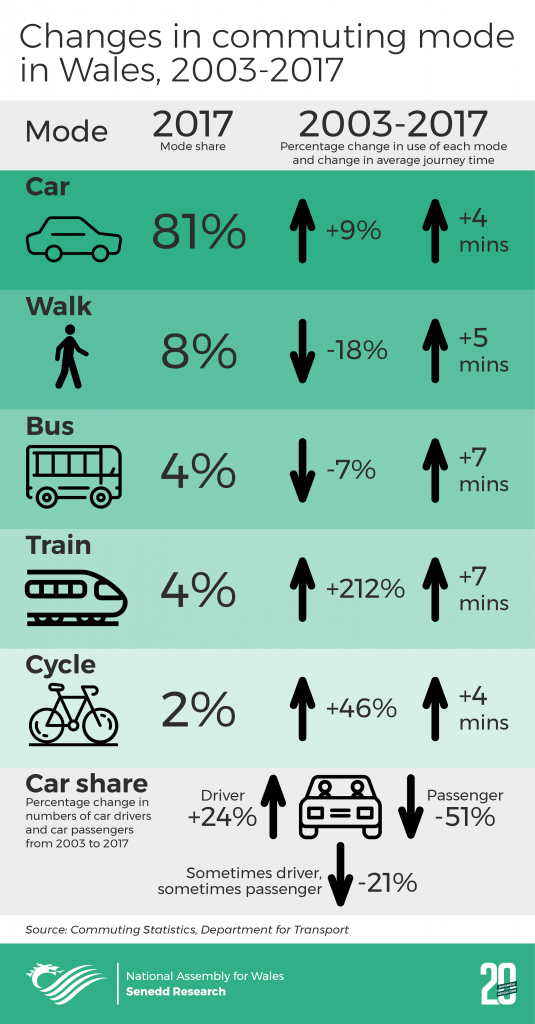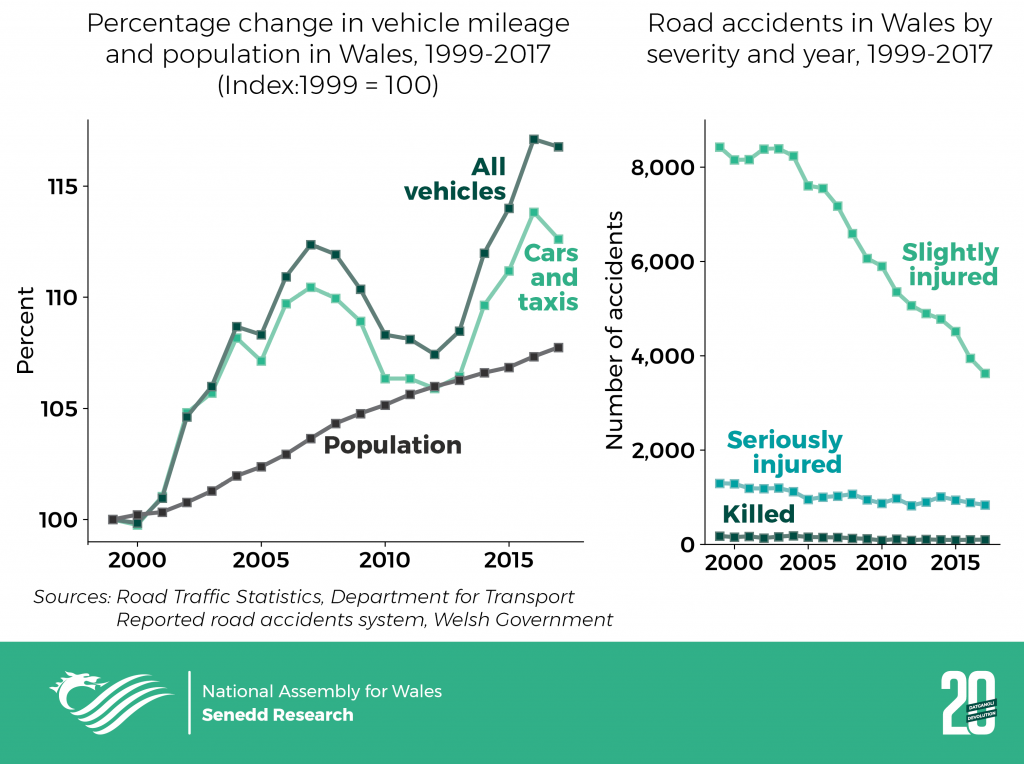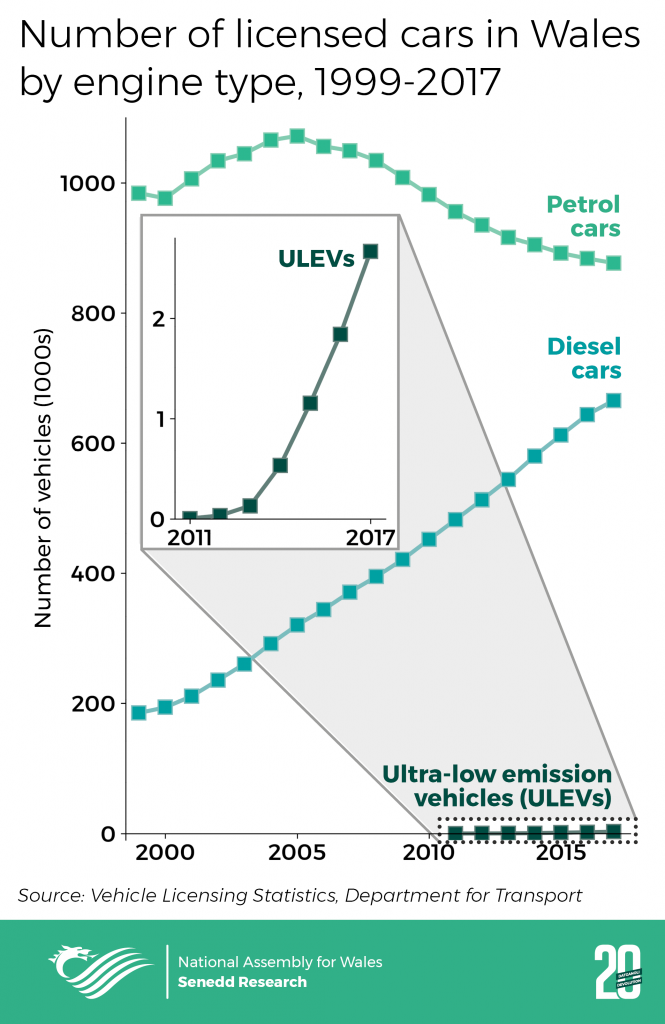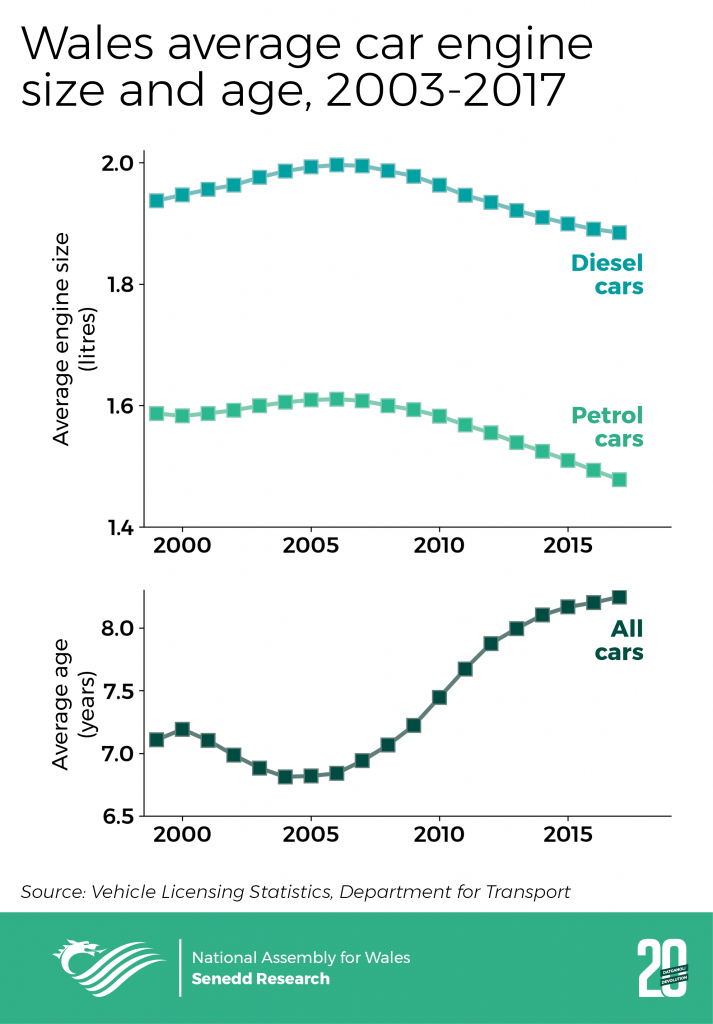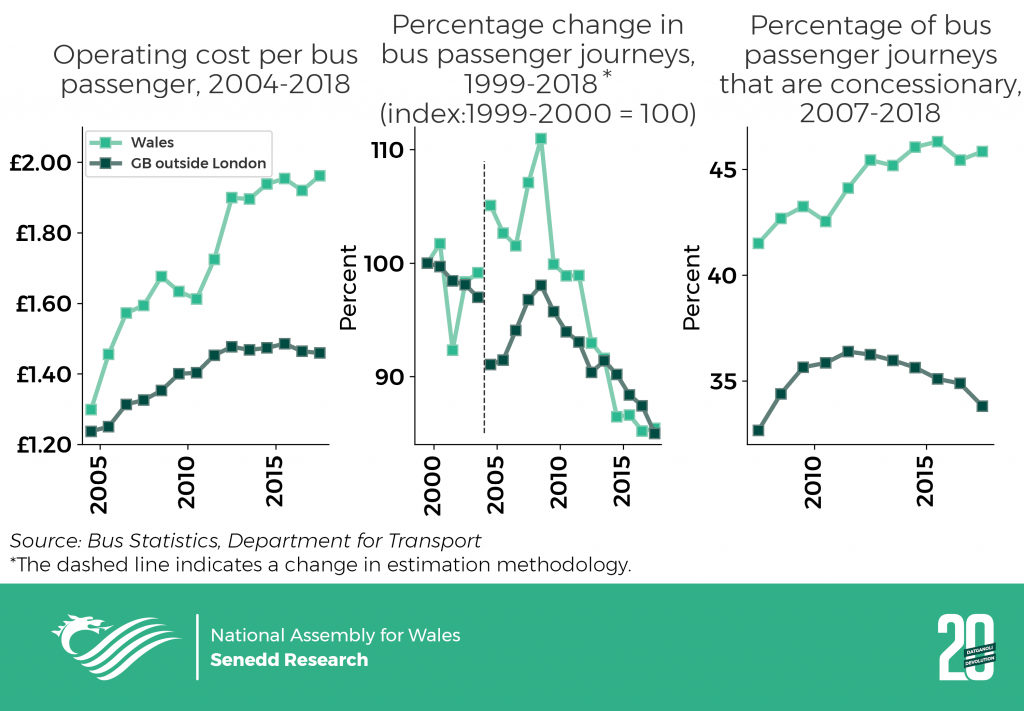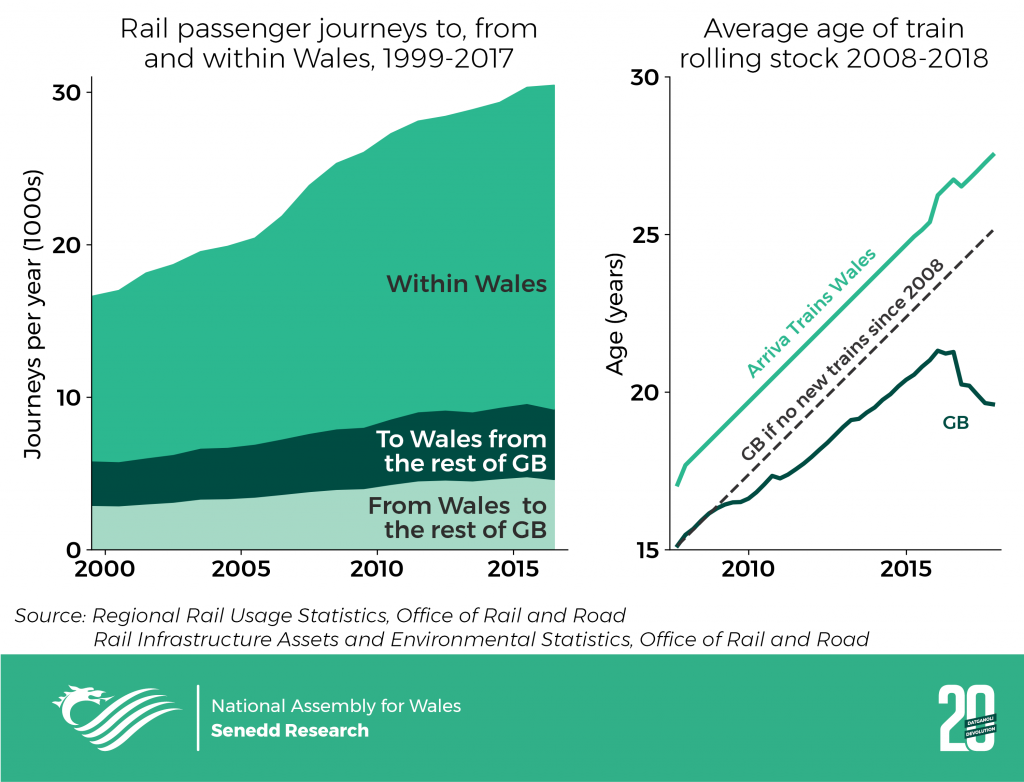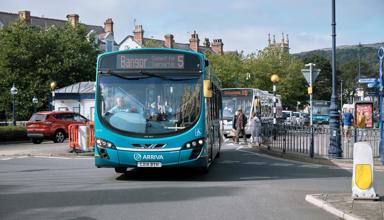Much has changed in Wales in the twenty years since the first National Assembly for Wales was elected in May 1999. This is the second in a series of articles that attempts to describe some of that change. It has been prepared by Senedd Research as part of the Assembly’s activity to mark twenty years of devolution.
Against a backdrop of increasing devolution – culminating in the Wales Act 2017 and devolution of rail franchising – our travel choices have changed since 1999. We drive and travel more by rail, use the bus less with walking and cycling rates remaining pretty static.
Yet future technology, social trends and policy changes will profoundly affect not only travel, but our health, economy and environment.
This article looks at how and why some of our choices in travelling around Wales by road, rail, bike and foot have changed, highlighting some key future issues.
Commuting
Our journeys to work illustrate wider trends in how we travel.
Commutes take longer, consistent with longer journeys and traffic congestion. Despite environmental, health and congestion concerns, the car increasingly dominates, and more of us travel alone.
Bus travel declined - though it remains more popular than rail despite rocketing rail journeys.
While walking has declined, cycling has grown – however only 2% of us commuted by bike in 2017.
Active travel
Active travel is often seen as key to addressing some major public health, environmental and transport challenges – for example addressing increasing levels of excess weight and obesity in Wales.
While comparable walking and cycling data over the period are limited, commuting data suggest static active travel rates. Wider sources support this.
The most recent Welsh Government data show the Active Travel (Wales) Act 2013 has had limited impact on active travel rates.
Active travel is defined as walking and cycling as a means of transport, i.e. to reach a particular destination rather than for pleasure, health or exercise.
Using this definition, the Welsh Government data show numbers cycling at least 5 to 10 minutes weekly hovered around 6% between 2013-14 and 2017-18. While 58% walked weekly in 2017-18, this was down from over 65% in 2013-14. Although a change in data collection methodology in 2017-18 means direct comparisons can’t be drawn with previous years, it’s pretty clear there hasn’t been a significant change.
The 2013 Act, which originated from a petition submitted to the Assembly’s Petitions Committee in 2007, was described as a “game changer” at the time by Ministers. It aims to promote active travel and improve infrastructure, replacing a previous non-statutory approach.
Yet following post-legislative scrutiny of the Act by the Economy, Infrastructure and Skills (EIS) Committee in 2018, the Chair concluded that “a lack of leadership, funding and ambition have contributed to the poor outcome to date”.
The Committee found evidence (PDF 784) that barriers to behaviour change are complex, including concerns about road and personal safety, cost and the quality of infrastructure.
While calls for action have led to increased Welsh Government funding, it’s not yet proven that Welsh active travel policy is effective.
Car ownership and road traffic
Despite a downturn during the recession - total road traffic has increased by nearly 17% since 1999 and car traffic by about 12%. Both have significantly outstripped population growth.
Despite traffic growth, accident data show our roads are safer. Accidents resulting in death or serious injury decreased by about 44% and 35% respectively between 1999 and 2017. An even more substantial decrease in slight injuries (57%) means total “injury accidents” are down around 54%. This mirrors a post 1960s UK-wide trend reflecting action on drink driving and vehicle and road safety.
The number and type of cars we drive has changed. Since 1999 total Welsh car ownership is up 24% to about 1.5m cars, similar to the rate across Great Britain (23%).
Wales has seen strong diesel growth - reflecting the so called “dash for diesel.” From the early 2000s Vehicle Excise Duty (VED) incentivised the purchase of lower CO2 emitting engines, including diesel despite their greater air quality / health impacts (though manufacturers highlight that new diesels compare favourably to petrol).
More recently, focus on air quality, fall-out from the 2015 “Dieselgate” emissions scandal and VED changes have seen new diesel registrations across Great Britain fall.
Our car engines are smaller – consistent with VED changes and improved engine technology. It’s also clear that, as in the UK as a whole, we drive older cars, partly reflecting the impact of the recession.
The debate on whether new road construction is sustainable is long running reflecting the apparent tension between economic and environmental priorities.
The decision on the M4 relief road is a test case for many. And removal of the Severn Bridge Tolls last December following a long campaign already seems to have increased traffic.
Wales has some of the worst UK air quality - including the most polluted road in Britain outside London. With most local air pollution caused by road vehicle emissions, and legal action leading the Welsh Government to set out plans to address air quality this will be an area to watch.
On climate change, the Environment (Wales) Act 2016 committed Wales to major carbon emission reductions. UK Committee on Climate Change (UKCCC) data show that transport makes up a lower proportion (13%) of total Welsh emissions compared to the UK as a whole (28%), partly due to the prevalence of large energy and industrial emitters in Wales.
However, the UKCCC proposes significantly greater reductions in emissions from transport compared to, for example, industry to achieve Welsh emissions targets. While action is also needed on bus, rail and freight, cars are by some way the biggest source of Welsh transport CO2 emissions.
The UKCCC proposes significant Welsh uptake of ultra-low emission vehicles (ULEVs), along with shifts to public transport use and active travel. Although Welsh ULEV ownership has grown steeply (see above), only 760 new plug-in vehicles were registered in 2017 – 1.6% of the UK total.
Currently Wales has just 3.1% of UK charging connectors. Clearly action beyond the Welsh Government’s £2m investment in trunk road charging infrastructure will be needed to support ULEV uptake.
Development of “Connected and Autonomous Vehicles”, including self-driving cars, will be another area to watch. Despite technical challenges and plenty of sceptics, advocates predict a public and private transport revolution. The UK Government wants fully autonomous cars on UK roads by 2021. While the main policy drivers are non-devolved, the EIS Committee recently identified (PDF 1MB) opportunities and challenges for Wales – and proposed a role for the Welsh Government as an “enabler, facilitator and co-ordinator” for the technology.
Bus travel
Trends in bus passenger numbers show how the Welsh Government’s introduction of the UK’s first nationwide concessionary bus pass from 2002 helped reverse the post-1980s decline in bus patronage. The policy has had a huge impact on the lives of older and disabled people – with 46 million Welsh concessionary journeys (ODS, 47.2KB) made in 2017-18.
However, the decline in passengers since 2008-09 has been steep – a concern given the socio-economic importance of bus travel. While this reflects the trend across Great Britain (outside London), the Welsh slump has been significant in the last decade.
Although tempting to look for simple explanations – austerity or bus industry deregulation - the causes of decline are a complex mix of socio-economic factors, including alternatives to bus and public attitudes.
As the chart above illustrates, bus operating costs per passenger have increased more quickly in Wales since 2004-05 than elsewhere in Great Britain (outside London). While data also show higher revenue per passenger, this too has declined since 2011-12. Meanwhile, traffic congestion affects industry costs, and cash-strapped local government can’t plug gaps with subsidised services.
Concessionary journeys have comprised a higher proportion of total Welsh journeys than elsewhere. While these provide revenue, operators are not reimbursed a full fare. The Welsh Government concluded this “contributed to bus fare inflation in Wales”.
The Welsh Government has published White Paper proposals for statutory “tools” for local authorities planning bus services using newly devolved powers, and to increase the eligibility age for concessionary passes. Having withdrawn funding for local government Regional Transport Consortia in 2014, the Government also proposes new national/regional statutory local government structures – to plan services more effectively. Yet reversing the decline is a significant challenge.
Rail travel
Unlike bus patronage, Welsh rail travel has grown, with most growth within Wales. While four franchises currently have Welsh services, most Welsh rail travel in the period has been via the much maligned Arriva Trains Wales (ATW) franchise.
Prior to ATW, Welsh services were fractured. The ATW franchise, awarded by the Strategic Rail Authority (SRA) in 2003, comprised elements of three former franchises.
The SRA assumed zero passenger growth and required minimal investment by ATW. With hindsight this was a misjudgement given subsequent passenger growth and overcrowded rolling stock which, as the franchise ended, had an average age of 28 years – nearly 8 years higher than the average for Great Britain by 2018.
Criticism grew despite additional investment by ATW, and substantial Welsh Government investment in rail after it took over franchise management in 2006.
Yet the Auditor General for Wales noted that since 2006 ATW’s performance improved – albeit unevenly. In 2017 the Welsh Affairs Select Committee (WASC) found that ATW exceeded contractual Public Performance Measure (PPM) targets for punctuality and reliability and official data show ATW near the top of PPM league tables.
However this apparent success disguised growing overcrowding and dissatisfaction. ATW told WASC that limited capacity, poor rolling stock and engineering works affected National Rail Passenger Survey results and impacted on customer and staff feedback.
Given this dissatisfaction, rail has been a key focus in the Assembly. Major Committee inquiries were undertaken into the rail franchise and rail infrastructure in the Fourth Assembly, and further work done on preparations for the new rail franchise in this Assembly.
However, hopes are high for the new TfWRail franchise, procured and managed by Transport for Wales (TfW), the Welsh Government’s new transport delivery company, using franchise powers devolved in 2018.
Despite a rocky start (PDF 534KB) from October 2018, the contract will see significant public investment over 15 years in what is the highest value contract awarded by the Welsh Government to date. Exciting changes are planned including new rolling stock, electrification of the Core Valleys Lines, increased service frequencies and smart ticketing.
The contract is innovative – not least as the Welsh Government takes ownership of the Core Valleys Lines to develop electric South Wales Metro services.
The travelling public will hope for similar action on Swansea and North Wales Metros, as well as results from the Welsh Government “case for investment” in rail infrastructure, published in 2018, which sets out proposals for major investment in Welsh rail.
The Welsh Government remains frustrated by the limits to rail devolution – particularly that rail infrastructure remains reserved. Cancellation of Cardiff to Swansea electrification in 2017, primarily due to cost overruns, is now a symbol of perceived UK Government neglect of Welsh rail. The “root and branch” Williams Review of rail in Great Britain may offer hope that on-going frustrations may be eased.
The next 20 years promise even greater transformation in how we travel in Wales. In 2039 we might ask how successfully we embraced the challenge of revolutionary technology, supported and integrated public transport, reduced environmental impact and ensured transport sustainably underpinned our society and economy. The Assembly will be watching the Welsh Government closely to make sure Wales is moving in the right direction.
The next article to be published tomorrow will look at health.
Article by Andrew Minnis, Senedd Research, National Assembly for Wales






